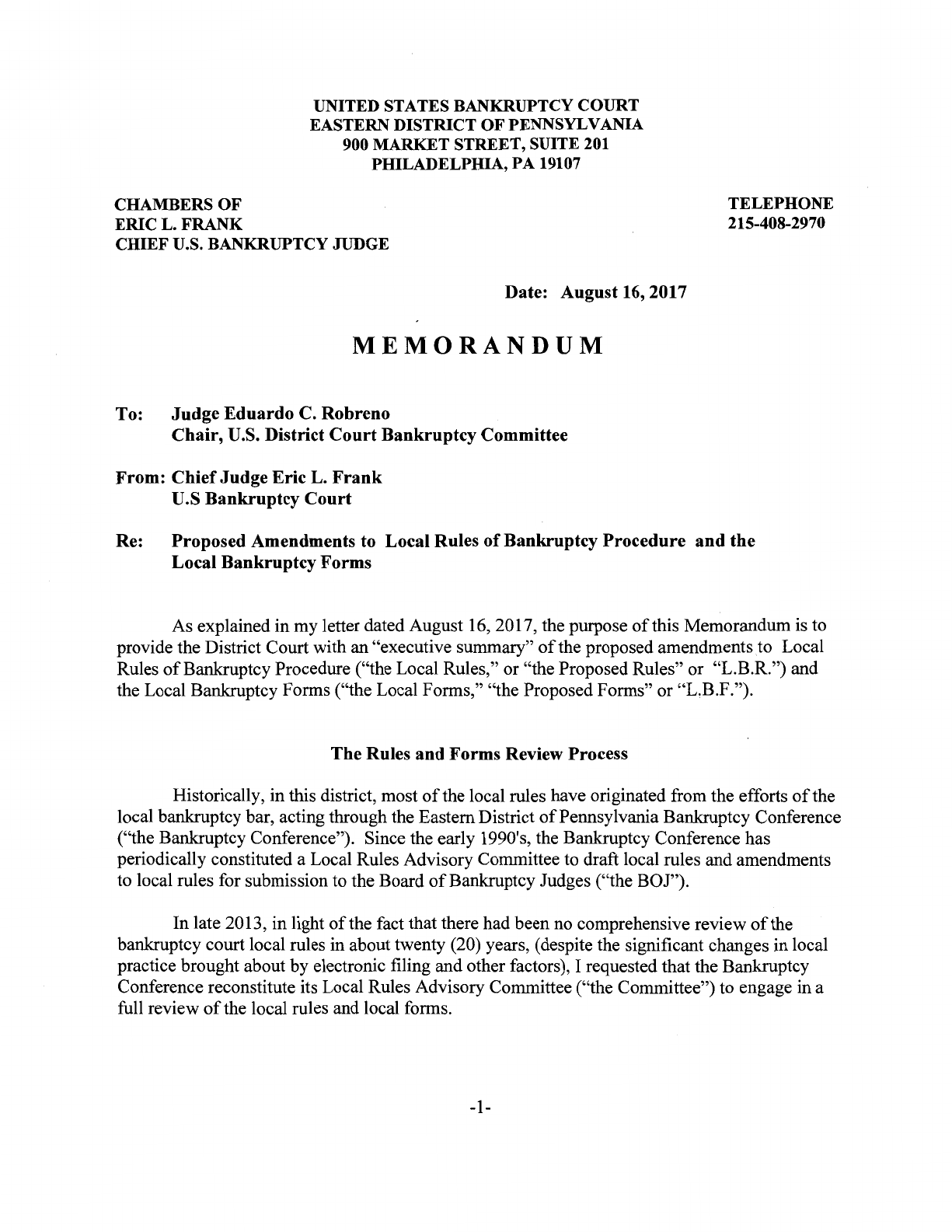
CHAMBERS
OF
ERIC
L.
FRANK
UNITED STATES BANKRUPTCY COURT
EASTERN DISTRICT
OF
PENNSYLVANIA
900
MARKET
STREET, SUITE 201
PHILADELPHIA,
PA
19107
CHIEF
U.S. BANKRUPTCY JUDGE
Date: August 16, 2017
MEMORANDUM
To:
Judge
Eduardo
C. Robreno
Chair,
U.S. District
Court
Bankruptcy
Committee
From:
Chief
Judge
Eric
L.
Frank
U.S
Bankruptcy
Court
TELEPHONE
215-408-2970
Re: Proposed Amendments to Local Rules
of
Bankruptcy
Procedure
and
the
Local
Bankruptcy
Forms
As explained in my letter dated August 16, 2017, the purpose
of
this Memorandum is to
provide the District Court with an "executive summary"
of
the proposed amendments to Local
Rules
of
Bankruptcy Procedure ("the Local Rules," or "the Proposed Rules" or "L.B.R.") and
the Local Bankruptcy Forms ("the Local Forms," "the Proposed Forms" or "L.B.F.").
The
Rules
and
Forms
Review Process
Historically, in this district, most
of
the local rules have originated from the efforts
of
the
local bankruptcy bar, acting through the Eastern District
of
Pennsylvania Bankruptcy Conference
("the Bankruptcy Conference"). Since the early 1990's, the Bankruptcy Conference has
periodically constituted a Local Rules Advisory Committee to draft local rules and amendments
to local rules for submission to the Board
of
Bankruptcy Judges ("the BOJ").
In late 2013, in light
of
the fact that there had been no comprehensive review
of
the
bankruptcy court local rules in about twenty (20) years, (despite the significant changes in local
practice brought about by electronic filing and other factors), I requested that the Bankruptcy
Conference reconstitute its Local Rules Advisory Committee ("the Committee") to engage in a
full review
of
the local rules and local forms.
-1-
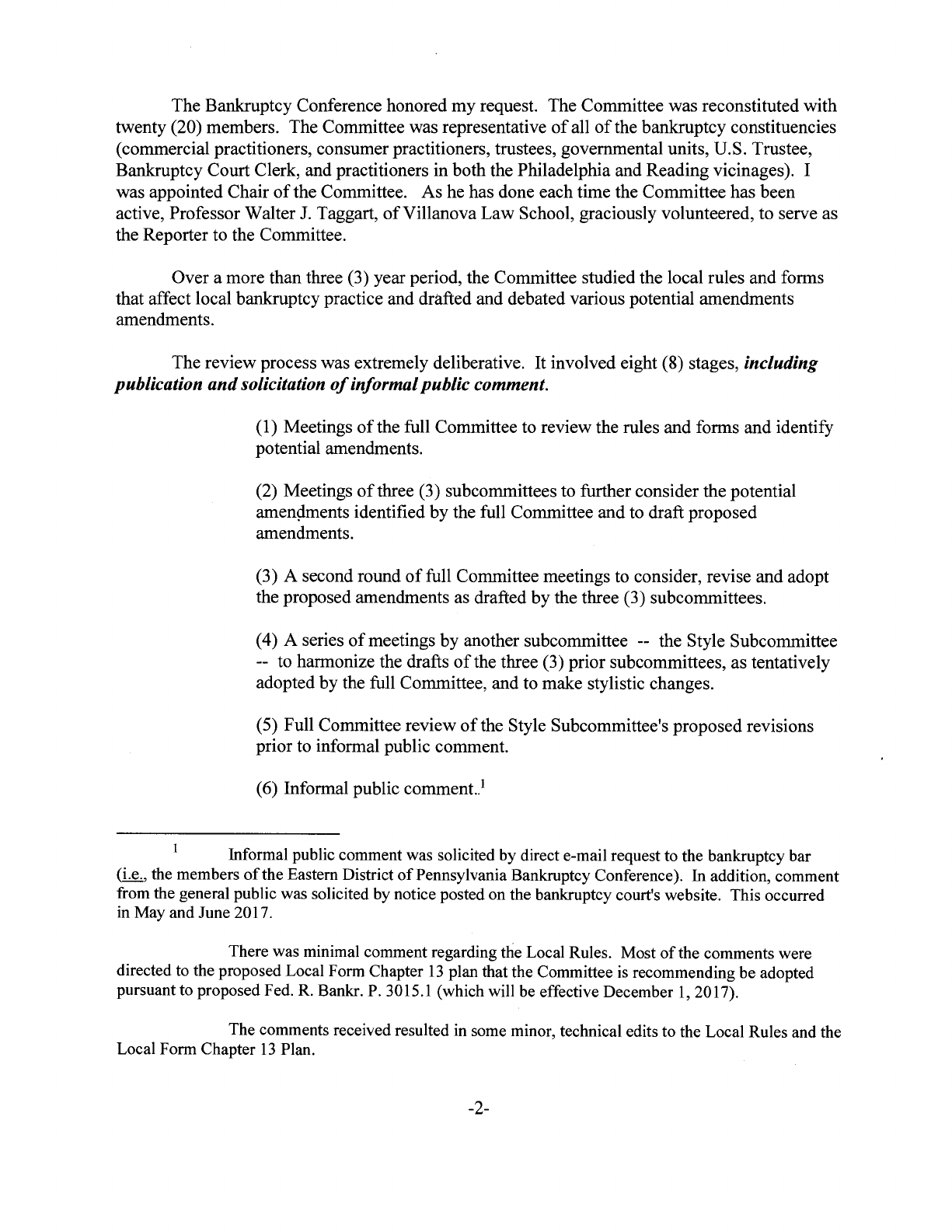
The Bankruptcy Conference honored
my
request. The Committee was reconstituted with
twenty (20) members. The Committee was representative
of
all
of
the bankruptcy constituencies
(commercial practitioners, consumer practitioners, trustees, governmental units, U.S. Trustee,
Bankruptcy Court Clerk, and practitioners in both the Philadelphia and Reading vicinages ). I
was appointed Chair
of
the Committee.
As
he has done each time the Committee has been
active, Professor Walter J. Taggart,
of
Villanova
Law
School, graciously volunteered, to serve as
the Reporter to the Committee.
Over a more than three (3) year period, the Committee studied the local rules and forms
that affect local bankruptcy practice and drafted and debated various potential amendments
amendments.
The review process was extremely deliberative.
It
involved eight (8) stages, including
publication and solicitation
of
informal public comment.
(1) Meetings
of
the full Committee to review the rules and forms and identify
potential amendments.
(2) Meetings
of
three (3) subcommittees to further consider the potential
amen9.ments identified
by
the full Committee and to draft proposed
amendments.
(3) A second round
of
full Committee meetings to consider, revise and adopt
the proposed amendments as drafted
by
the three (3) subcommittees.
(4) A series
of
meetings
by
another subcommittee -- the Style Subcommittee
-- to harmonize the drafts
of
the three (3) prior subcommittees, as tentatively
adopted by the full Committee, and to make stylistic changes.
(5) Full Committee review
of
the Style Subcommittee's proposed revisions
prior to informal public comment.
(6) Informal public comment..
1
Informal public comment was solicited by direct e-mail request to the bankruptcy bar
(i.e., the members
of
the Eastern District
of
Pennsylvania Bankruptcy Conference).
In
addition, comment
from the general public was solicited by notice posted on the bankruptcy court's website. This occurred
in May and June 2017.
There was minimal comment regarding tlie Local Rules. Most
of
the comments were
directed to the proposed Local Form Chapter
13
plan that the Committee is recommending be adopted
pursuant to proposed Fed.
R.
Bankr. P. 3015.1 (which will be effective December
1,
2017).
The comments received resulted in some minor, technical edits to the Local Rules and the
Local Form Chapter
13
Plan.
-2-
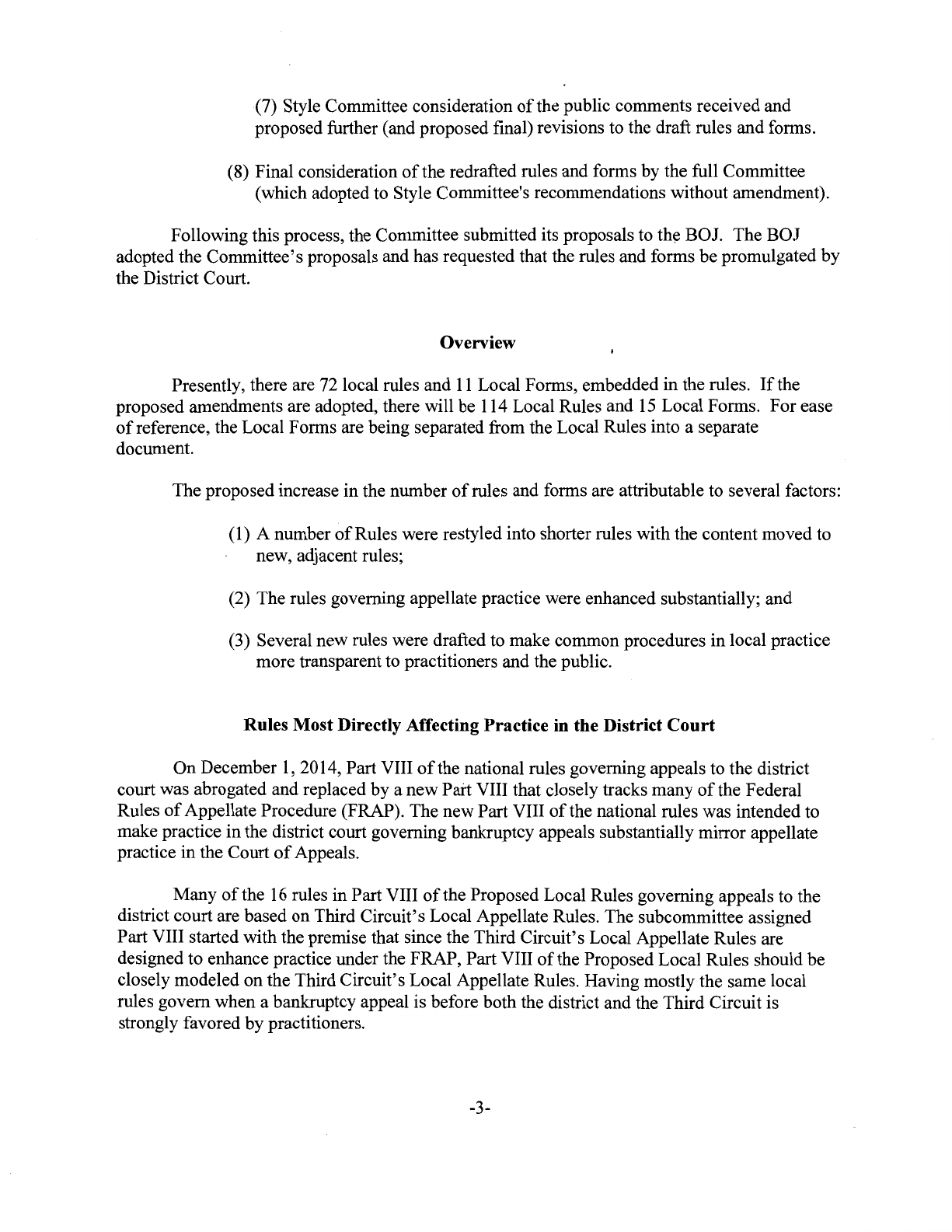
(7) Style Committee consideration
of
the public comments received and
proposed further (and proposed final) revisions to the draft rules and forms.
(8) Final consideration
of
the redrafted rules and forms by the full Committee
(which adopted to Style Committee's recommendations without amendment).
Following this process, the Committee submitted its proposals to the BOJ. The BOJ
adopted the Committee's proposals and has requested that the rules and forms be promulgated by
the District Court.
Overview
Presently, there are 72 local rules and
11
Local Forms, embedded in the rules.
If
the
proposed amendments are adopted, there will be 114 Local Rules and
15
Local Forms. For ease
of
reference, the Local Forms are being separated from the Local Rules into a separate
document.
The proposed increase in the number
of
rules and forms are attributable to several factors:
(1) A number
of
Rules were restyled into shorter rules with the content moved to
new, adjacent rules;
(2) The rules governing appellate practice were enhanced substantially; and
(3) Several new rules were drafted to make common procedures in local practice
more transparent to practitioners and the public.
Rules Most Directly Affecting Practice in the District Court
On December
1,
2014, Part VIII
of
the national rules governing appeals to the district
court was abrogated and replaced by a
new
Part VIII that closely tracks many
of
the Federal
Rules
of
Appellate Procedure (FRAP). The new Part VIII
of
the national rules was intended to
make practice in the district court governing bankruptcy appeals substantially mirror appellate
practice in the Court
of
Appeals.
Many
of
the
16
rules in Part VIII
of
the Proposed Local Rules governing appeals to the
district court are based
on
Third Circuit's Local Appellate Rules. The subcommittee assigned
Part VIII started with the premise that since the Third Circuit's Local Appellate Rules are
designed to enhance practice under the FRAP, Part VIII
of
the Proposed Local Rules should be
closely modeled on the Third Circuit's Local Appellate Rules. Having mostly the same local
rules govern when a bankruptcy appeal is before both the district and the Third Circuit is
strongly favored by practitioners.
-3-
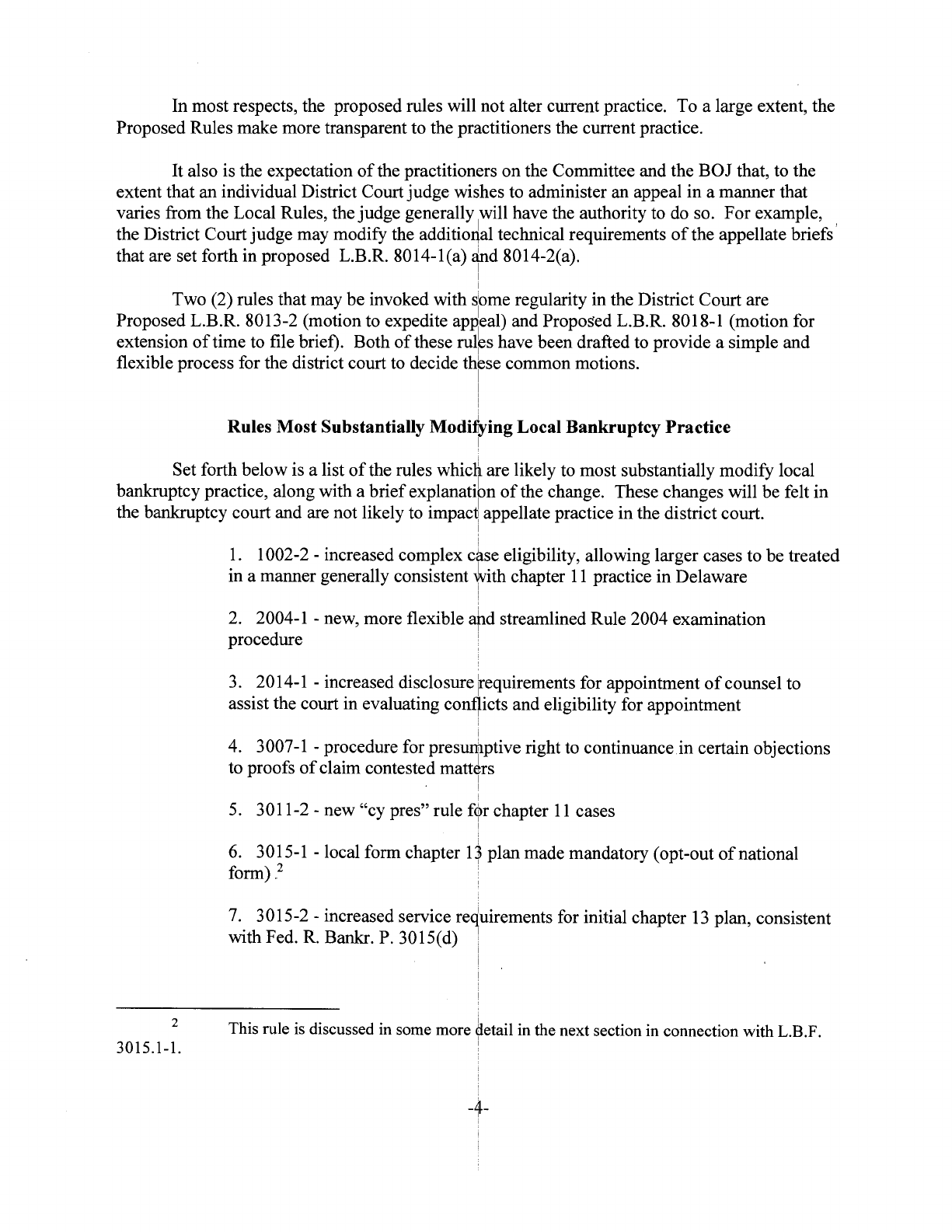
In most respects, the proposed rules will not alter current practice. To a large extent, the
Proposed Rules make more transparent to the practitioners the current practice.
It
also is the expectation
of
the practitioners on the Committee and the BOJ that, to the
extent that an individual District Court judge wishes to administer an appeal in a manner that
varies from the Local Rules, the judge generally will have the authority to do so. For example,
the District Court judge may modify the additiodal technical requirements
of
the appellate briefs'
that are set forth in proposed L.B.R. 8014-l(a)
a'nd
8014-2(a).
I
I
Two (2) rules that may be invoked with sbme regularity in the District Court are
Proposed L.B.R. 8013-2 (motion to expedite
ap~eal)
and Proposed L.B.R. 8018-1 (motion for
extension
of
time to file brief). Both
of
these
rul~s
have been drafted to provide a simple and
flexible process for the district court to decide
ise
common motions.
i
Rules Most Substantially
Modif~ing
Local Bankruptcy Practice
I
Set forth below is a list
of
the rules
whicli.
are likely to most substantially modify local
bankruptcy practice, along with a brief explanatibn
of
the change. These changes will be felt in
the bankruptcy court and are not likely to
impac~
appellate practice in the district court.
2
3015.1-1.
I
I
1.
1002-2 - increased complex case eligibility, allowing larger cases to be treated
in a manner generally consistent
*ith
chapter
11
practice in Delaware
!
2.
2004-1 - new, more flexible apd streamlined Rule 2004 examination
procedure
1
3.
2014-1 - increased disclosure !requirements for appointment
of
counsel to
assist the court in evaluating conf1icts and eligibility for appointment
i
4. 3007-1 - procedure for presuniiptive right to continuance.in certain objections
to proofs
of
claim contested mattJrs
I
I
5.
3011-2 - new "cy pres" rule
f~r
chapter
11
cases
I
6.
3015-1 - local form chapter d plan made mandatory (opt-out
of
national
form)
..
2
,
7.
3015-2 - increased service requirements for initial chapter
13
plan, consistent
with Fed.
R.
Bankr.
P.
3015(d)
1
i
This rule is discussed in some more detail in the next section in connection with L.B.F.
I
-4-
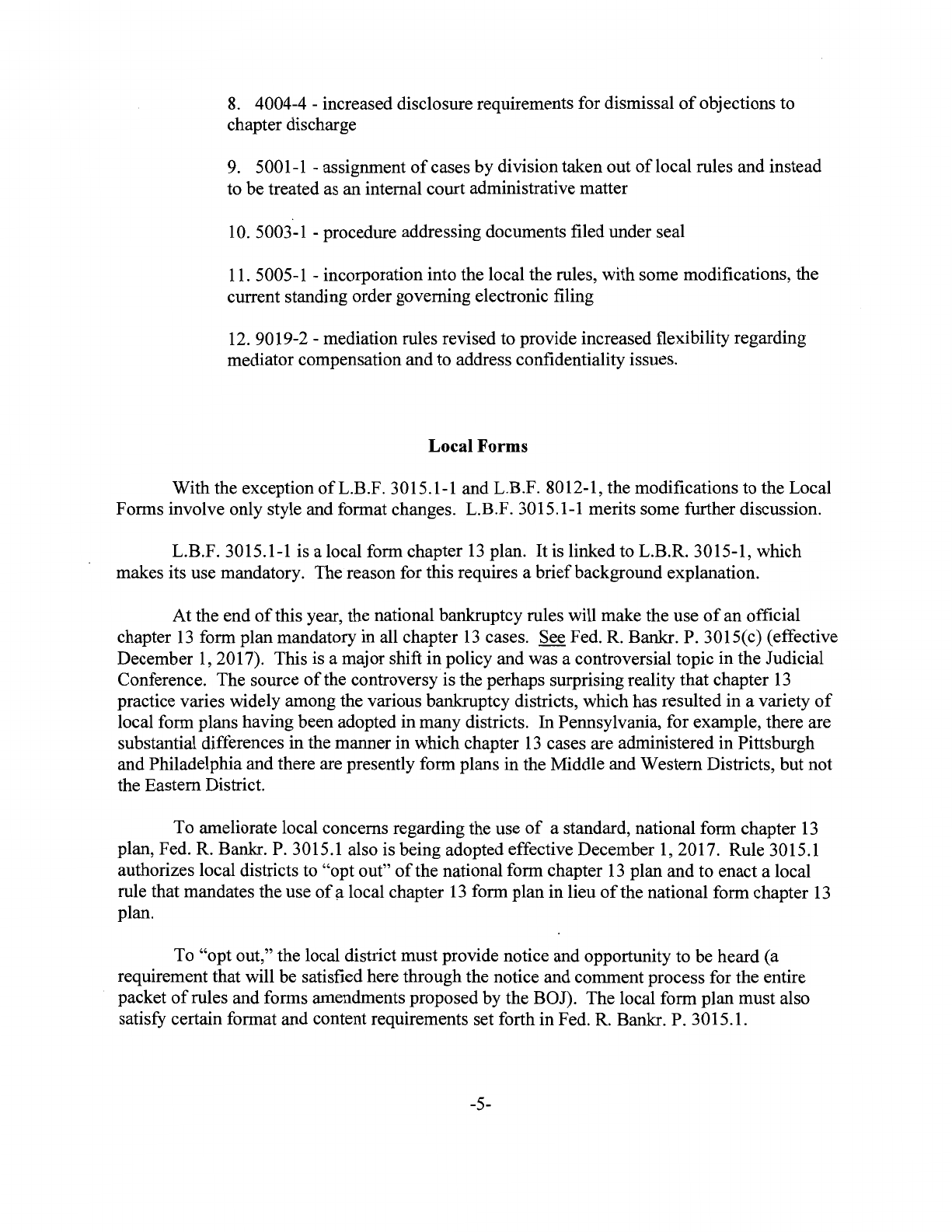
8.
4004-4 - increased disclosure requirements for dismissal
of
objections to
chapter discharge
9. 5001-1 - assignment
of
cases by division taken out
oflocal
rules and instead
to
be
treated as an internal court administrative matter
10. 5003-1 - procedure addressing documents filed under seal
11. 5005-1 - incorporation into the local the rules, with some modifications, the
current standing order governing electronic filing
12. 9019-2 - mediation rules revised to provide increased flexibility regarding
mediator compensation and to address confidentiality issues.
Local Forms
With
the exception
ofL.B.F.
3015.1-1 and L.B.F. 8012-1, the modifications to the Local
Forms involve only style and format changes. L.B.F. 3015.1-1 merits some further discussion.
L.B.F. 3015.1-1 is a local form chapter
13
plan.
It
is linked to L.B.R. 3015-1, which
makes its use mandatory. The reason for this requires a
brief
background explanation.
At
the end
of
this year, the national bankruptcy rules will make the use
of
an
official
chapter
13
form plan mandatory in all chapter
13
cases. See Fed. R. Bankr. P. 3015(c) (effective
December
1,
2017). This is a major shift
in
policy and was a controversial topic in the Judicial
Conference. The source
of
the controversy is the perhaps surprising reality that chapter
13
practice varies widely among the various bankruptcy districts, which has resulted
in
a variety
of
local form plans having been adopted
in
many districts. In Pennsylvania, for example, there are
substantial differences in the manner in which chapter
13
cases are administered in Pittsburgh
and Philadelphia and there are presently form plans in the Middle and Western Districts, but not
the Eastern District.
To ameliorate local concerns regarding the use
of
a standard, national form chapter
13
plan, Fed. R. Bankr. P. 3015.1 also is being adopted effective December
1,
2017. Rule 3015.1
authorizes local districts to
"opt
out"
of
the national form chapter
13
plan and to enact a local
rule that mandates the use
of
i:i
local chapter
13
form plan in lieu
of
the national form chapter
13
plan.
To
"opt
out," the local district must provide notice and opportunity to be heard (a
requirement that will be satisfied here through the notice and comment process for the entire
packet
of
rules and forms amendments proposed
by
the BOJ). The local form
plan
must also
satisfy certain format and content requirements set forth
in
Fed. R. Bankr. P. 3015 .1.
-5-
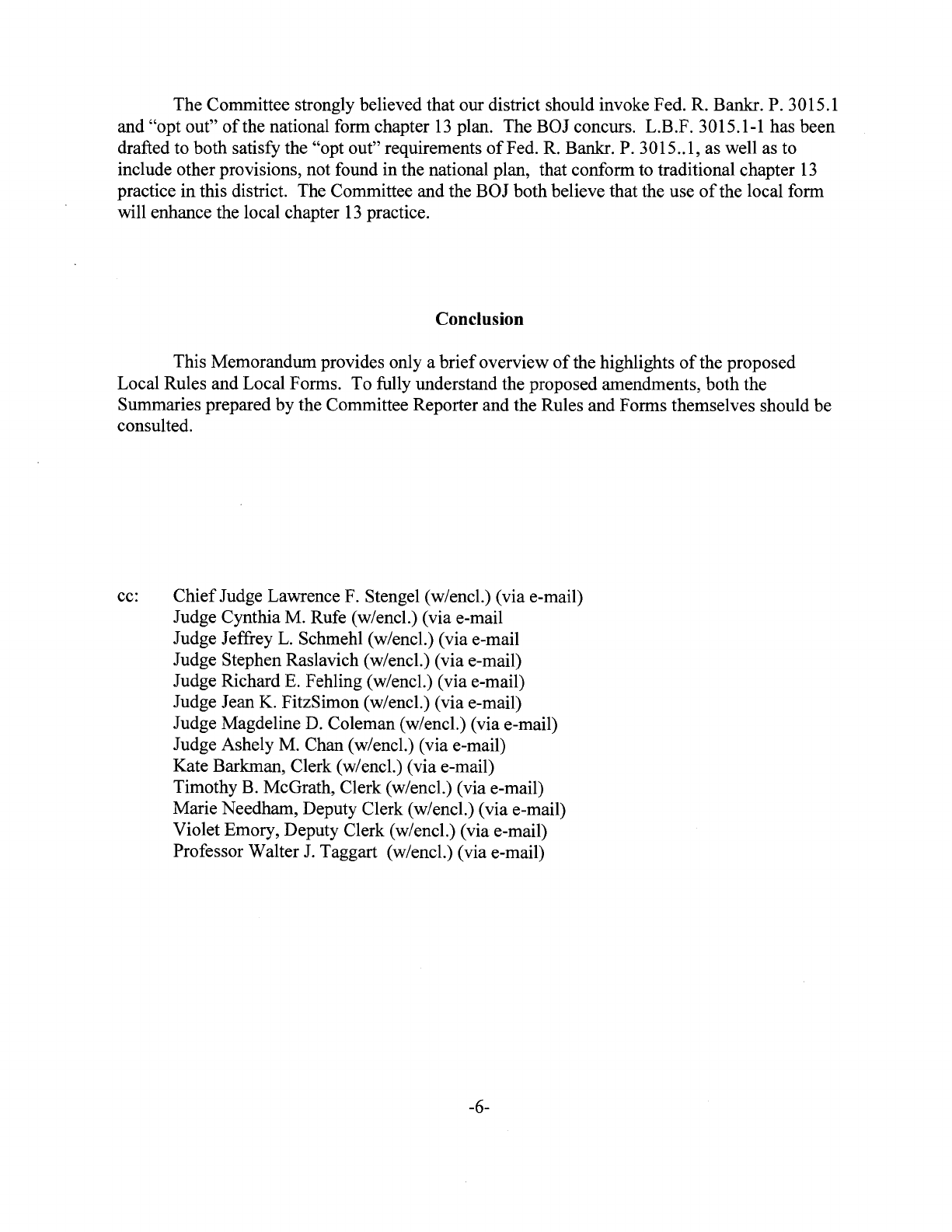
The Committee strongly believed that our district should invoke Fed.
R.
Bankr. P. 3015.l
and "opt out"
of
the national form chapter
13
plan. The BOJ concurs. L.B.F. 3015.1-1 has been
drafted to both satisfy the "opt out" requirements
of
Fed.
R.
Bankr.
P.
3015 . .1, as well as to
include other provisions, not found in the national plan, that conform to traditional chapter
13
practice in this district. The Committee and the BOJ both believe that the use
of
the local form
will enhance the local chapter
13
practice.
Conclusion
This Memorandum provides only a brief overview
of
the highlights
of
the proposed
Local Rules and Local Forms. To fully understand the proposed amendments, both the
Summaries prepared by the Committee Reporter and the Rules and Forms themselves should be
consulted.
cc: Chief Judge Lawrence
F.
Stengel (w/encl.) (via e-mail)
Judge Cynthia M. Rufe (w/encl.) (via e-mail
Judge Jeffrey
L.
Schmehl (w/encl.) (via e-mail
Judge Stephen Raslavich (w/encl.) (via e-mail)
Judge Richard
E.
Fehling (w/encl.) (via e-mail)
Judge Jean
K.
FitzSimon (w/encl.) (via e-mail)
Judge Magdeline
D.
Coleman (w/encl.) (via e-mail)
Judge Ashely
M.
Chan (w/encl.) (via e-mail)
Kate Barkman, Clerk (w/encl.) (via e-mail)
Timothy
B.
McGrath, Clerk (w/encl.) (via e-mail)
Marie Needham, Deputy Clerk (w/encl.) (via e-mail)
Violet Emory, Deputy Clerk (w/encl.) (via e-mail)
Professor Walter
J.
Taggart (w/encl.) (via e-mail)
-6-
